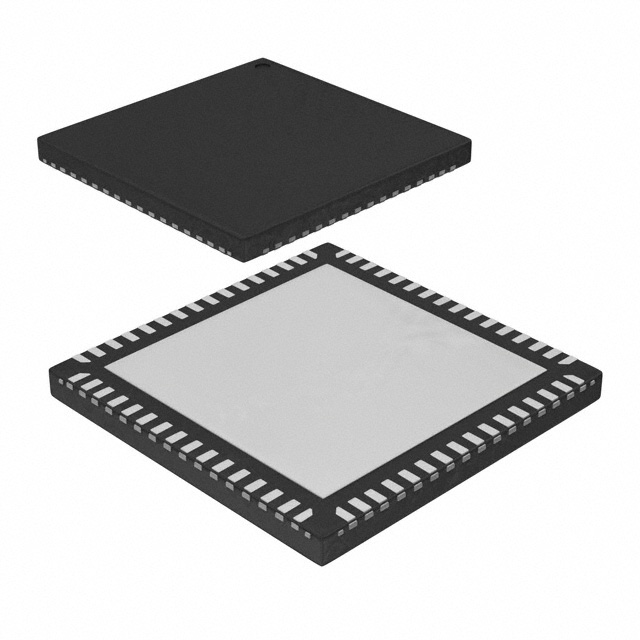ATMEGA169L-4MC
Product Overview
Category
ATMEGA169L-4MC belongs to the category of microcontrollers.
Use
This microcontroller is commonly used in various electronic devices and systems for controlling and processing data.
Characteristics
- Low-power consumption
- High-performance 8-bit AVR microcontroller
- Offers a wide range of features and peripherals
- Suitable for applications requiring low power consumption and high integration
Package
ATMEGA169L-4MC is available in a compact package, making it suitable for small-sized electronic devices.
Essence
The essence of ATMEGA169L-4MC lies in its ability to provide efficient control and processing capabilities in a compact and low-power package.
Packaging/Quantity
ATMEGA169L-4MC is typically packaged in trays or reels, with each containing a specific quantity of microcontrollers. The exact packaging and quantity may vary depending on the manufacturer.
Specifications
- Architecture: 8-bit AVR
- Flash Memory: 16KB
- SRAM: 1KB
- EEPROM: 512 bytes
- Operating Voltage: 2.7V - 5.5V
- Speed Grade: 4MHz
- Number of I/O Pins: 32
- Communication Interfaces: UART, SPI, I2C
- Analog-to-Digital Converter (ADC): 10-bit, 8 channels
- Timers/Counters: 3 x 16-bit, 1 x 8-bit
- PWM Channels: 6
- Operating Temperature Range: -40°C to +85°C
Detailed Pin Configuration
The ATMEGA169L-4MC microcontroller has a total of 64 pins. The pin configuration is as follows:
- Port A (PA0-PA7)
- Port B (PB0-PB7)
- Port C (PC0-PC7)
- Port D (PD0-PD7)
Each port consists of 8 pins, allowing for various input/output configurations.
Functional Features
1. Low Power Consumption
ATMEGA169L-4MC is designed to operate at low power levels, making it suitable for battery-powered devices and energy-efficient applications.
2. High Integration
With a wide range of features and peripherals, this microcontroller offers high integration capabilities, reducing the need for external components and simplifying circuit design.
3. Communication Interfaces
The built-in UART, SPI, and I2C interfaces enable seamless communication with other devices, expanding the connectivity options for the microcontroller.
4. Analog-to-Digital Conversion
The integrated 10-bit ADC allows for precise analog signal measurements, making it ideal for applications that require accurate sensor readings.
Advantages and Disadvantages
Advantages
- Low power consumption extends battery life in portable devices.
- High integration reduces the need for additional components, saving cost and board space.
- Versatile communication interfaces enhance connectivity options.
- Precise analog-to-digital conversion enables accurate sensor readings.
Disadvantages
- Limited processing power compared to higher-bit microcontrollers.
- Smaller memory capacity may restrict the complexity of applications.
Working Principles
ATMEGA169L-4MC operates based on the AVR architecture, utilizing its core features such as the CPU, memory, and peripherals. The microcontroller executes instructions stored in its flash memory, processes data, and interacts with external devices through its I/O pins and communication interfaces.
Detailed Application Field Plans
ATMEGA169L-4MC finds applications in various fields, including but not limited to: - Consumer electronics - Industrial automation - Internet of Things (IoT) devices - Medical equipment - Automotive systems
The microcontroller's low power consumption, high integration, and versatile features make it suitable for a wide range of applications.
Detailed and Complete Alternative Models
Some alternative models to ATMEGA169L-4MC that offer similar functionality and characteristics include: - ATMEGA328P - ATMEGA2560 - PIC16F877A - STM32F103C8T6
These microcontrollers can be considered as alternatives based on specific requirements and project constraints.
In conclusion, ATMEGA169L-4MC is a high-performance 8-bit AVR microcontroller with low power consumption and high integration capabilities. It offers a wide range of features and peripherals, making it suitable for various electronic applications. While it has certain limitations in terms of processing power and memory capacity, its advantages outweigh the disadvantages, making it a popular choice among designers and developers.
قم بإدراج 10 أسئلة وإجابات شائعة تتعلق بتطبيق ATMEGA169L-4MC في الحلول التقنية
What is the operating voltage range of ATMEGA169L-4MC?
- The operating voltage range of ATMEGA169L-4MC is 2.7V to 5.5V.What is the maximum CPU frequency of ATMEGA169L-4MC?
- The maximum CPU frequency of ATMEGA169L-4MC is 8 MHz.Can ATMEGA169L-4MC be used for battery-powered applications?
- Yes, ATMEGA169L-4MC's low operating voltage range makes it suitable for battery-powered applications.What are the communication interfaces supported by ATMEGA169L-4MC?
- ATMEGA169L-4MC supports USART, SPI, and I2C communication interfaces.Is ATMEGA169L-4MC suitable for industrial control applications?
- Yes, ATMEGA169L-4MC's robust features make it suitable for industrial control applications.What is the flash memory size of ATMEGA169L-4MC?
- ATMEGA169L-4MC has 16 KB of in-system self-programmable flash memory.Can ATMEGA169L-4MC be used in temperature-sensitive environments?
- Yes, ATMEGA169L-4MC has a wide operating temperature range, making it suitable for temperature-sensitive environments.Does ATMEGA169L-4MC have built-in analog-to-digital converters (ADC)?
- Yes, ATMEGA169L-4MC has an 8-channel 10-bit ADC.What development tools are available for programming ATMEGA169L-4MC?
- Development tools such as Atmel Studio and AVR-GCC can be used for programming ATMEGA169L-4MC.Can ATMEGA169L-4MC be used in automotive applications?
- Yes, ATMEGA169L-4MC's robust design and wide operating voltage range make it suitable for automotive applications.


